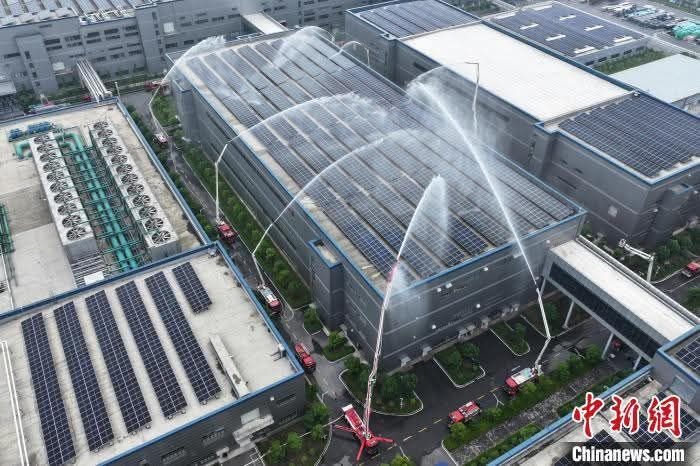 By [jithu], [23-06-2025]Wuhan, a major city in central China’s Hubei Province, played host on Tuesday to a large-scale firefighting drill unlike any seen before. The exercise wasn’t just about extinguishing flames—it was a vivid demonstration of how modern technology and human expertise are joining forces to tackle a rapidly evolving challenge: fires caused by new energy sources, including electric vehicles (EVs) and lithium-ion battery plants.With the rise of the green energy revolution, the firefighting profession is undergoing a transformation. As countries race to meet carbon neutrality targets, the proliferation of electric vehicles and energy storage systems has introduced a new spectrum of fire hazards. This drill, organized by local emergency response units and supported by several high-tech companies, served as both a test of preparedness and a showcase of futuristic firefighting tools.
By [jithu], [23-06-2025]Wuhan, a major city in central China’s Hubei Province, played host on Tuesday to a large-scale firefighting drill unlike any seen before. The exercise wasn’t just about extinguishing flames—it was a vivid demonstration of how modern technology and human expertise are joining forces to tackle a rapidly evolving challenge: fires caused by new energy sources, including electric vehicles (EVs) and lithium-ion battery plants.With the rise of the green energy revolution, the firefighting profession is undergoing a transformation. As countries race to meet carbon neutrality targets, the proliferation of electric vehicles and energy storage systems has introduced a new spectrum of fire hazards. This drill, organized by local emergency response units and supported by several high-tech companies, served as both a test of preparedness and a showcase of futuristic firefighting tools.
The Challenge of New Energy Fires
Traditional fire emergencies—those involving wood, fabric, oil, or gas—are well understood by firefighting professionals. However, new energy fires, especially those caused by lithium-ion batteries, present unique risks. These fires can burn hotter, last longer, and may reignite unpredictably even after appearing extinguished.EV battery fires, in particular, have proven difficult to control. The energy density of lithium-ion cells, combined with the potential for thermal runaway reactions, makes conventional suppression techniques less effective. Battery fires in energy storage facilities can emit toxic gases and create domino effects if not quickly contained.Recognizing the need for updated tactics and tools, Wuhan’s firefighting authorities staged a comprehensive emergency response simulation aimed at testing cutting-edge strategies.
High-Tech Arsenal on Display
At the heart of the demonstration was an impressive lineup of technology designed to support frontline responders while minimizing risk to human life.
- Robot Dogs: These agile, quadruped robots were seen navigating hazardous terrain, scouting fire zones, and transmitting real-time video and thermal imagery back to command centers.
- Drones: Unmanned aerial vehicles (UAVs) provided overhead surveillance and helped map fire spread patterns. Fitted with thermal cameras and smoke-penetrating sensors, they delivered crucial data for situational awareness.
- Fire Bots: Remotely operated firefighting robots entered the blaze directly, spraying suppressant foam and water while enduring intense heat.
Together, this array of equipment demonstrated the growing synergy between man and machine in emergency response. Human firefighters coordinated with AI-powered devices, using data streams from robotic scouts and aerial drones to devise real-time strategies for fire suppression and rescue.
Simulated Scenarios and Realistic Challenges
The drill included multiple scenarios simulating realistic accidents: an electric vehicle charging station catching fire due to a battery malfunction, a warehouse storing lithium battery packs going up in flames, and an explosion at a solar power plant.In each case, rapid response teams deployed a mix of conventional and robotic forces. Human firefighters established safety perimeters and monitored toxic gas levels, while drones conducted flyovers to locate hotspots. Fire bots, guided remotely from mobile command vehicles, tackled the most dangerous zones.Importantly, the drill emphasized communication between devices. AI algorithms helped integrate data from all platforms—ground robots, aerial drones, and wearable sensors—into a centralized dashboard accessible by commanders.
Training for the Future
Beyond its impressive tech display, the Wuhan drill underscored a more fundamental shift: the evolution of firefighter training. Firefighters are acquiring new skills—not only in firefighting, but in data analysis, drone piloting, robotic interface control, and hazardous materials management.Many of the responders in the Wuhan drill had undergone months of specialized training. The exercise also offered a live test of inter-agency cooperation involving EMS, police, and power grid operators.
A Glimpse Into Smart Firefighting
The Wuhan drill represents more than just a preparedness exercise—it signals a vision of the future. As cities become smarter and industries adopt more electric and renewable energy systems, firefighting must keep pace. Technological integration is no longer optional; it’s essential.Smart firefighting doesn’t mean replacing humans with machines. Rather, it enhances human capabilities with intelligent support systems. Robot dogs can access collapsed tunnels humans can’t. Drones can quickly identify gas leaks from above. AI can sift through data faster than any human team.
National and Global Relevance
China’s investment in new energy infrastructure is among the most ambitious in the world. With millions of electric vehicles on the road and dozens of battery production facilities operating nationwide, fire departments face new risks at an unprecedented scale.Wuhan’s drill offers a template not only for other Chinese cities but for global fire agencies preparing to meet similar challenges.
Final Thoughts
The firefighting drill held in Wuhan is a powerful reminder that emergency response must evolve in step with technological progress. As the world embraces clean energy and smart cities, the tools for disaster response must become just as smart.By embracing robot dogs, drones, and AI-driven systems, Wuhan’s emergency services have taken a bold step into the future of firefighting. The results of the drill suggest a promising path forward—one where lives are better protected, risks are more manageable, and the line between human heroism and machine precision becomes a seamless collaboration.For more stories on smart city development and emergency tech innovation, stay tuned to our Technology & Safety section.










